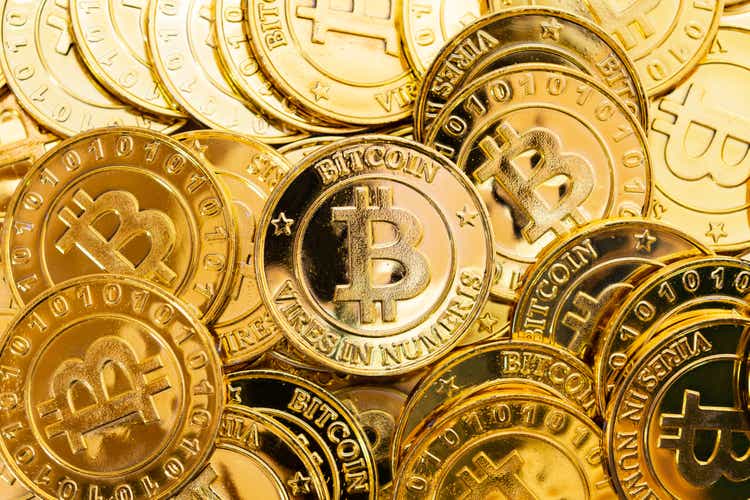‘Million Dollar Bitcoin’: How It Could Happen (BTC-USD)


Tevarak
ARK Invest CEO Cathie Wood’s call for Bitcoin (BTC-USD) to reach “$1 million by 2030” in late November 2022 was widely received as outlandish, but Bitcoin’s features are such that this scenario cannot be ruled out.
BTC stocks with gold and silver a unique property of a financial asset: it is nobody else’s responsibility. This is often touted by Bitcoin promoters as a way to protect citizens’ assets from the old banking system that is perceived to be predatory when it comes to remittances and lacking in privacy. Keeping Bitcoin in cold storage is a guarantee of full control over one’s holdings, while a bank account can only be accessed with the bank’s consent. It is important to emphasize that only cold storage involves this unique feature: keeping Bitcoin with an institution, be it an intermediary or an exchange, deprives Bitcoin of this most valuable quality, as FTX customers have just found out.
While this is clearly important to certain individuals – especially libertarians – it is even more important to countries: central banks hold reserve funds to ensure they can finance imports from abroad as needed or to prop up the value of their national currency when it comes under pressure if investors leave the country. Currently, the bulk of these reserve funds are in US dollars and, for some countries, in gold. The relationship between the world’s central banks is what constitutes the international monetary system, namely the links that allow trade between countries (imports and exports) and cross-border financing and investment.
The international monetary system is built on the US$ as a reserve currency. What is a reserve currency? It is the currency unanimously accepted as settlement for cross-border transactions. It is also the currency in which commodities and oil are denominated. The US$, like all fiat currencies, is the responsibility of the central bank that issues it, the Fed in this case. Like all fiat currencies, the dollar is effectively debt. It is debt issued by the dominant country, the United States.
As trade and investment across national borders expands, there is a need for a steady supply of reserve currency so that the issuing country can increase its debt, which we in the US are happy to do. Adding debt for a country means consuming more than producing, then importing more than exporting, running a trade deficit and Congress spending more than tax revenue and running a budget deficit. Economists call the resulting deficit “running a current account deficit,” namely allowing foreigners to finance excess spending.
So issuing a reserve currency is essentially akin to a person signing off the grocery store’s invoice and never paying for it, as the store owner can use the signed invoice to pay his suppliers or creditors who accept the claim of the privileged person as settlement. We in the United States are the privileged individual.
This alleviates America’s budget constraint: we can spend more than we produce. It also gives the US an awe-inspiring power over other countries. We can impose stinging sanctions against hostile foreigners: North Korea, Iran, Afghanistan and now Russia can confirm it.
What happens if the acceptance of US IOUs as a means of settlement – and the power this implies for the US – is questioned? There will be a need for a replacement remedy. This actually happened in the past, when in the 60s France’s General de Gaulle and French economist Jacques Rueff considered the US$ role an “exorbitant privilege” and moved France’s gold from the New York Fed vaults back to Paris.
De Gaulle’s political legacy essentially withered and nothing came of it. But today’s situation is different. In particular, the fault line between China and the US has widened. Sanctions against Russia have sent a clear American message to would-be dissenters: “You can run, but you can’t hide as your assets are our responsibility, so they are as good as we want them to be”. Should that message encourage US$ holders to try to diversify away from the Greenback, the question becomes what substitute can at least complement the dollar, if not replace it?
Gold is the existing candidate: Gold is actually nobody else’s responsibility: it is already a traditional central bank reserve. Its role is hampered by its uneven distribution. It is mostly held by the traditional advanced economies, the United States and Continental Europe. It also suffers from cumbersome transfer procedures for settlement purposes. It is equally difficult to share. There is definitely room for an alternative asset that shares gold’s characteristics but without these drawbacks. Crypto assets held in cold storage solve all the above problems. Others have advocated this idea.
Let us emphasize that central banks have already developed a great interest in digital currencies, but for the wrong reasons: Central Bank Digital Currencies (CBDCs) would be the responsibility of the national central bank – much different from Bitcoin – and indeed would potentially allow greater government control over citizens. The Fed published a comprehensive study on CBDCs, highlighting privacy concerns as well as impacts on the legacy banking system. Other places are digital yuan is already widely used in China, at an experimental stage, potentially eliminating any privacy protection for local residents.
Bitcoin’s finite nature is a key part of its attraction. Admittedly, there is no shortage of competition from other cryptos. Nevertheless, Bitcoin’s decentralization and security are unparalleled among cryptoassets and therefore make it appropriate as a global unfettered means of reserve. It is scarce, fungible, immutable, non-seizable, pseudonymous, peer to peer, does not require trust or permission. As such, Bitcoin checks all the boxes for the ideal reserve asset: held in cold storage, it is the ultimate inventory that offers ironclad benefits as a last-resort store of value.
Should the move towards using BTC as a reserve asset materialize, the price implications will obviously be dramatic. At the moment, the sum of the central banks’ reserve funds is anywhere between 40 trillion and 50 trillion dollars. Should half of these reserves over time be converted to BTC, $25 trillion would chase the total amount of 21 million BTC. The math is easy to do, we will actually be looking at a BTC price of roughly $1.2 million. Unlike Cathie Wood, I don’t expect this to happen between now and 2030. Still, I don’t rule out a phase-in of BTC holdings from central banks for all the reasons above. This will provide a strong official sector demand supporting the value of Bitcoin, potentially to the mysterious million number over time.
Risks of this scenario
- So far, only one small country, El Salvador, has decided to add Bitcoin to its foreign reserves, which has sparked strong criticism from the International Monetary Fund, which is not interested in letting countries free themselves from IMF dependence. Russia’s fate of being thrown out of access to its reserves may nevertheless inspire others to diversify their assets away from other countries’ liabilities. Bitcoin offers such an alternative, since gold is already concentrated among a few countries.
- Bitcoin volatility can also be seen as a major deterrent, since a reserve asset must have a predictable value. A move towards inclusion in reserve assets will largely give Bitcoin a legitimacy that is likely to drive its value higher, far higher and trigger a virtuous cycle where the current unbound value (pun intended) will be replaced by an orderly rise in value followed by a stabilization at high level.

























